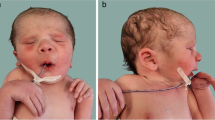Abstract
Distal arthrogryposis (DA) is composed of a group of clinically and genetically heterogeneous disorders, characterized by multiple congenital contractures of the limbs. Point mutations in three genes encoding contractile fast-twitch myofibers, TPM2, TNNI2 and TNNT3, were recently identified in DA type 1 (DA1; MIM 108120) and DA type 2B (DA2B; MIM 601680). We have described a large Chinese DA family in which different individuals had phenotypes similar to DA1 or DA2B. To map the disease locus in this family, two-point linkage analysis was first performed using microsatellite markers selected from the genomic regions close to the TPM2, TNNI2/TNNT3 and TNNC2 genes. A positive LOD score of 3.61 at θ = 0 was obtained with the marker close to the TNNI2/TNNT3 genes, corresponding to the genetic mapping site of DA2B. Direct sequencing of the PCR-amplified DNA fragment spanning exon 8 of the TNNI2 gene showed a heterozygous deletion, c.523_525delAAG (p.K175del), in the proband. This novel mutation was confirmed to cosegregate with the DA phenotype in affected individuals but not detected in all unaffected individuals of the family and not in 50 healthy controls. In summary, we have found a novel TNNI2 mutation in a Chinese family with DA2B. Our work represents the first report on the link between TNNI2 and the DA phenotype in Chinese.




Similar content being viewed by others
References
Bamshad M, Jorde LB, Carey JC (1996) A revised and extended classification of the distal arthrogryposes. Am J Med Genet 65:277–281
Bamshad M, Watkins WS, Zenger RK, Bohnsack JF, Carey JC, Otterud B, Krakowiak PA, Robertson M, Jorde LB (1994) A gene for distal arthrogryposis type I maps to the pericentromeric region of chromosome 9. Am. J Hum Genet 55:1153–1158
Freeman EA, Sheldon JH (1938) Cranio-carpotarsal dystrophy: undescribed congenitalmalformation. Arch Dis Child 13:277–283
Hall JG, Reed SD, Greene G (1982) The distal arthrogryposes: delineation of new entities—review and nosologic discussion. Am J Med Genet 11:185–239
Jiang M, Han WT, Bian CY, Wang G, Li WZ, Sun LN, Yang Z (2004) Report of a rare distal arthrogrophy large family. Hereditas (Beijing) 26:803–806
Klemp P, Hall JG (1995) Dominant distal arthrogryposis in a Maori family with marked variability of expression. Am J Med Genet 55:414–419
Krakowiak PA, O’Quinn JR, Bohnsack JF, Watkins WS, Carey JC, Jorde LB, Bamshad M (1997) A variant of Freeman–Sheldon syndrome maps to 11p15.5-pter. Am J Hum Genet 60:426–432
Krakowiak PA, Bohnsack JF, Carey JC, Bamshad M (1998) Clinical analysis of a variant of Freeman–Sheldon syndrome (DA2B). Am J Med Genet 76:93–98
Rintala AE (1968) Freeman–Sheldon’s syndrome, cranio–carpo–tarsal dystrophy. Acta Paediatr Scand 57:553–556
Sung SS, Brassington AME, Grannatt K, Rutherford A, Whitby FG, Krakowiak PA, Jorde LB, Carey JC, Bamshad M (2003a) Mutations in genes encoding fast-twitch contractile proteins cause distal arthrogryposis syndromes. Am J Hum Genet 72:681–690
Sung SS, Brassington AME, Krakowiak PA, Carey JC, Jorde LB, Bamshad M (2003b) Mutations in TNNT3 cause multiple congenital contractures: a second locus for distal arthrogryposis type 2B. Am J Hum Genet 73:212–214
Toydemir R, Stevenson D, Jorde LB, Carey J, Bamshad M (2005) Freeman–Sheldon syndrome is caused by defects in myosin. Abstracts of the 2005 ASHG annual meeting
Veugelers M, Bressan M, McDermott DA, Weremowicz S, Morton CC, Mabry CC, Lefaivre JF, Zunamon A, Destree A, Chaudron JM, Basson CT (2004) Mutation of perinatal myosin heavy chain associated with a Carney complex variant. N Engl J Med 351:460–469
Wettstein A, Buchinger G, Braun A, von Bazan UB (1980) A family with whistling-face-syndrome. Hum Genet 55:177–189
Acknowledgments
We thank all the family members for participating in this study. This study was supported by the Research Fund from the Liaoning Provincial Department of Science and Technology, the National 863 Program of China (2001AA221101 and 2002BA711A07–09), the NSFC Fund for Creative Research Groups (30421003), and the China Medical Board of New York, Inc. (Grant No. 03–785). XZ is also a short-term trainee in the International Collaborative Genetics Research Training Program (NIH D43 TW06176).
Author information
Authors and Affiliations
Corresponding authors
Additional information
Miao Jiang and Xiuli Zhao contributed equally to the work
Rights and permissions
About this article
Cite this article
Jiang, M., Zhao, X., Han, W. et al. A novel deletion in TNNI2 causes distal arthrogryposis in a large Chinese family with marked variability of expression. Hum Genet 120, 238–242 (2006). https://doi.org/10.1007/s00439-006-0183-4
Received:
Accepted:
Published:
Issue Date:
DOI: https://doi.org/10.1007/s00439-006-0183-4




